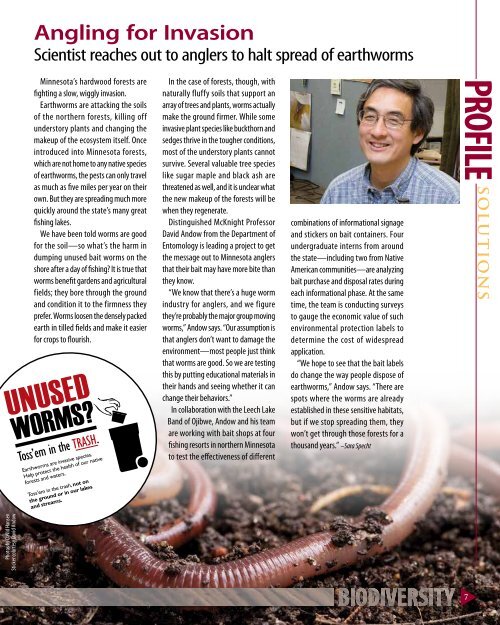PDF Version - College of Food, Agricultural and Natural Resource ...
PDF Version - College of Food, Agricultural and Natural Resource ...
PDF Version - College of Food, Agricultural and Natural Resource ...
Create successful ePaper yourself
Turn your PDF publications into a flip-book with our unique Google optimized e-Paper software.
UNUSED<br />
Photos by David Hansen<br />
Sticker courtesy David Andow<br />
Angling for Invasion<br />
Scientist reaches out to anglers to halt spread <strong>of</strong> earthworms<br />
Minnesota’s hardwood forests are<br />
fighting a slow, wiggly invasion.<br />
Earthworms are attacking the soils<br />
<strong>of</strong> the northern forests, killing <strong>of</strong>f<br />
understory plants <strong>and</strong> changing the<br />
makeup <strong>of</strong> the ecosystem itself. Once<br />
introduced into Minnesota forests,<br />
which are not home to any native species<br />
<strong>of</strong> earthworms, the pests can only travel<br />
as much as five miles per year on their<br />
own. But they are spreading much more<br />
quickly around the state’s many great<br />
fishing lakes.<br />
We have been told worms are good<br />
for the soil—so what’s the harm in<br />
dumping unused bait worms on the<br />
shore after a day <strong>of</strong> fishing? It is true that<br />
worms benefit gardens <strong>and</strong> agricultural<br />
fields; they bore through the ground<br />
<strong>and</strong> condition it to the firmness they<br />
prefer. Worms loosen the densely packed<br />
earth in tilled fields <strong>and</strong> make it easier<br />
for crops to flourish.<br />
WORMS?<br />
Toss’em in the TRASH.<br />
Earthworms are invasive species.<br />
Help protect the health <strong>of</strong> our native<br />
forests <strong>and</strong> waters.<br />
Toss’em in the trash, not on<br />
the ground or in our lakes<br />
<strong>and</strong> streams.<br />
In the case <strong>of</strong> forests, though, with<br />
naturally fluffy soils that support an<br />
array <strong>of</strong> trees <strong>and</strong> plants, worms actually<br />
make the ground firmer. While some<br />
invasive plant species like buckthorn <strong>and</strong><br />
sedges thrive in the tougher conditions,<br />
most <strong>of</strong> the understory plants cannot<br />
survive. Several valuable tree species<br />
like sugar maple <strong>and</strong> black ash are<br />
threatened as well, <strong>and</strong> it is unclear what<br />
the new makeup <strong>of</strong> the forests will be<br />
when they regenerate.<br />
Distinguished McKnight Pr<strong>of</strong>essor<br />
David Andow from the Department <strong>of</strong><br />
Entomology is leading a project to get<br />
the message out to Minnesota anglers<br />
that their bait may have more bite than<br />
they know.<br />
“We know that there’s a huge worm<br />
industry for anglers, <strong>and</strong> we figure<br />
they’re probably the major group moving<br />
worms,” Andow says. “Our assumption is<br />
that anglers don’t want to damage the<br />
environment—most people just think<br />
that worms are good. So we are testing<br />
this by putting educational materials in<br />
their h<strong>and</strong>s <strong>and</strong> seeing whether it can<br />
change their behaviors.”<br />
In collaboration with the Leech Lake<br />
B<strong>and</strong> <strong>of</strong> Ojibwe, Andow <strong>and</strong> his team<br />
are working with bait shops at four<br />
fishing resorts in northern Minnesota<br />
to test the effectiveness <strong>of</strong> different<br />
combinations <strong>of</strong> informational signage<br />
<strong>and</strong> stickers on bait containers. Four<br />
undergraduate interns from around<br />
the state—including two from Native<br />
American communities—are analyzing<br />
bait purchase <strong>and</strong> disposal rates during<br />
each informational phase. At the same<br />
time, the team is conducting surveys<br />
to gauge the economic value <strong>of</strong> such<br />
environmental protection labels to<br />
determine the cost <strong>of</strong> widespread<br />
application.<br />
“We hope to see that the bait labels<br />
do change the way people dispose <strong>of</strong><br />
earthworms,” Andow says. “There are<br />
spots where the worms are already<br />
established in these sensitive habitats,<br />
but if we stop spreading them, they<br />
won’t get through those forests for a<br />
thous<strong>and</strong> years.” –Sara Specht<br />
PrOFilE solutions<br />
7

















